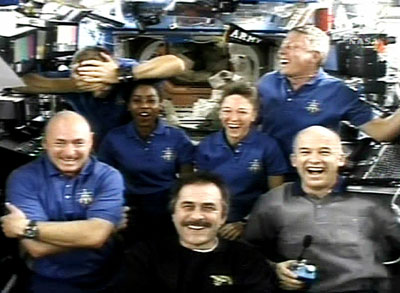All their assigned duties were completed and final precautionary tests had
turned up no problems Sunday, leaving weather the only question facing the
astronauts on the space shuttle Discovery as they looked forward to a return to
Earth.
Mission Control on Sunday gave the shuttle crew permission to try for a
landing Monday at the Kennedy Space Center in Florida, clearing all lingering
technical questions on the shuttle heat shield and the system that provides
hydraulic power for landing.

Piers Sellers (top, L)
covers his head as his crewmates laugh after he was described as the
spacewalker who lost the spatula during a crew news conference from aboard
the International Space Station in this view from NASA TV July 14, 2006.
The members of the crew are front row (L-R) Pilot Mark Kelly, ISS
Commander Pavel Vinogradov, Jeff Williams, and back row, Sellers,
Stephanie Wilson, Lisa Nowak and Mike Fossum.
[Reuters] |
"We feel very confident that
Discovery is safe to come home," landing director Steve Stich said in a news
conference Sunday. Re-entry is one of the two most dangerous parts of a shuttle
flight, along with the launch. A damaged heat shield caused Columbia to
disintegrate during re-entry in 2003.
The somewhat weary Discovery crew members were looking forward to returning
to their families on Monday, Stich told The Associated Press.
"We're getting ready to come home and we're just about there," Discovery
commander Steve Lindsey told NBC News on Sunday.
Lindsey said his crew members accomplished every one of their preflight goals
and did a little extra.
"I hope our legacy was that we closed out the return-to-flight test portion
of the program following the Columbia accident and we set the stage for space
station assembly to continue," he said Sunday. "Those were our two primary goals
and I think we achieved those goals."
Final inspections for heat shield damage on Friday and Saturday revealed no
problems caused by dust-size micro-meteorites.
And a test of a leaky power unit on Sunday looked good. The unit, one of
three on the shuttle, powers hydraulic systems used for steering and braking
during landing.
That left NASA with only one worry: the weather.
The concern involved a patch of rain expected to drift toward the Kennedy
Space Center from the north on Monday. The question was whether it would affect
either of the two possible landing times: 9:14 a.m. EDT and 10:50 a.m. EDT.
Stich said there was a "fairly reasonable" chance that the rain would hold
off long enough to allow Discovery to land.
If the weather prevents a landing Monday in Florida, Stich said, he will try
to bring the shuttle home on Tuesday at Kennedy or the backup site at Edwards
Air Force Base in California.
After Wednesday, the shuttle will run out of oxygen for its fuel cells and
breathing, deputy shuttle program manager John Shannon said.
Kennedy is the preferred landing site. A landing at Edwards costs NASA $1.7
million to fly the shuttle back to Florida atop a modified jumbo jet and could
add a week to the schedule for the shuttle's preparations for its next flight,
due in late August.
Wherever Discovery lands, it will have the benefit of four new tires and
wheels, each of which are two inches larger and 27 pounds heavier than previous
shuttle equipment. The new tires will increase the shuttle's load capacity by 20
percent and speed by 10 percent, Stich said.
"For the shuttle, they are the monster tires - tires and wheels," Stich said.
Another addition for this landing is a global positioning system, like the
equipment used in airliners and available in cars and airplanes, that should
provide a slight improvement for navigation, he said.
The astronauts said being in orbit put the violence in the Middle East in
perspective, with astronaut Stephanie Wilson saying: "looking down at Earth
reminds us that it's a wonderful place and that we should all live in peace and
harmony if we can."
"We just flew over the Middle East and I have to tell you, from up here it
looks peaceful and quiet just like the rest of the planet," astronaut Piers
Sellers told ABC News. "I think all of us are mindful from flying around and
around, this one little Earth, that it's all we have."